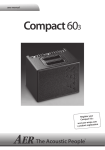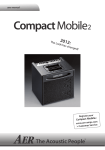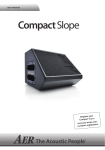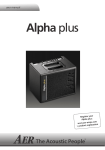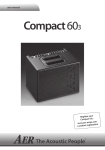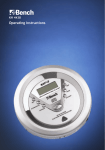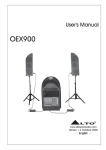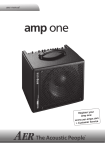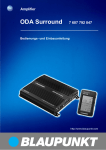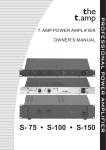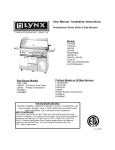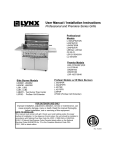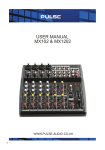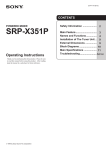Download Compact XL - DjangoBooks.com
Transcript
user manual Compact XL Register your Compact XL: .com www.aer-amps ration st gi > product re 1 Compact XL user manual Contents 1. Introduction 3 2. Important safety instructions 4 3. Controls and connections 3.1 Front side 3.2 Rear side 5 5 6 4. Starting up 4.1 Cabling and switching-on 4.2 Level adjustment 7 7 7 5. Functional Characteristics 5.1 Equalization 5.2 Effects 5.3 Footswitch 5.4 Phantom power 5.4.1 9V-Phantom power 5.4.2 48V-Phantom power 8 8 8 8 9 9 9 6. Technical Specifications 2 Page 10 1. Einleitung Welcome to B! Thank you for choosing the Compact XL. The Compact XL is a professional, compact and powerful amplifier system. Especially developed for the enhancement of acoustic instruments it is as well suitable for other (also electrical) instruments. Two separately adjustable channels offer you the simultaneous operation of instrument and microphone, as additional option you can loop a playbacksignal into your performance. The Compact XL is equipped with a highly efficient power amplifier and it’s 2-way speaker system guarantees distortion-free reproduction even at high volumes. All AER-systems are subtly dynamically controlled, which ensures absolute reliability in full load operation despite strikingly small sizes and little weight. Read on and have fun using your Compact XL! 3 2. Important Safety Instructions The following guidelines shall help minimize the risk of injury through fire or electric shock. C AU T I O N RISK OF ELECTRIC SHOCK DO NOT OPEN AT T E N T I O N RISQUE DE CHOC ELECTRIQUE NE PAS OUVRIR The lightning flash with the arrow head symbol within an equilateral triangle is intended to alert the user to the presence of unisolated ´dangerous voltage´ within this product´s enclosure that may be of sufficient magnitude to constitute a risk of electric shock to persons. 1. Carefully read these safety notes before you use the device! qualified staff only. Any unauthorized tampering will void the 2-year warranty. 2. Keep these safety notes in a safe place. 13. In keeping with the EMV regulations screened cables with correctly fitted connectors must be used for all signal connections. 3. Pay attention to all warnings, instructions and additional texts on the unit. 4. This device was only designed for operation under normal climatic conditions (temperate climate). 5. Do not install or use your amp in close proximity to water or if you are wet yourself. 6. Do not subject your device to sudden and severe temperature changes. This could cause moisture condensation inside the unit, which could damage it. In the event of moisture condensation allow the device to dry out completely before use. 7. Use your amp in a safe place where nobody can step on cables or trip over and damage them. 8. Pay attention to an unhindered air circulation around the amp, never obstruct the air vents or grilles. 9. Always pull the mains plug before cleaning your amp or when left unused for a long period of time. Use only a dry cloth for cleaning. Avoid the use of detergents and do not let any liquids seep into the unit. 10. Use only the right fuses with the same current rating and trigger characteristic as replacements. Never mend fuses! Pull the mains plug before replacing a fuse. Should a fuse blow again after a short while, the device needs to be checked. 4 The exclamation point within an equilateral triangle is intended to alert the user to the presence of important operating and maintenance (servicing) instructions in the literature accompanying this product. 14. Always use an earthed power supply with the correct mains voltage. If you are in doubt about the power outlet ground, have it checked by a qualified technician. 15. Cable up your amp only when it is powered off. 16. This device should be installed near the socket outlet and disconnection of the device should be easily accessible. The mains plug of the power supply shall remain readily operable. Protect the power cord from being walked on or pinched particularly at plugs, convenience receptacles and the point where they exit from the apparatus. 17. This product may cause permanent hearing loss. Do not operate for long periods of time at a high volume level or at any level that is uncomfortable. If you experience any hearing loss or ringing in the ears, you should consult an audiologist. 18. The product should be located away from heat sources such as radiators, heat registers or other products that produce heat. 19. Do not place any open sources of fire, like candles, on the device. 11. Never install your amp close to devices with strong electromagnetic fields such as large mains transformers, revolving machines, neon illumination etc. Do not lay signal cables parallel to power current cables. 20. Care should be taken so that objects do not fall onto the device and liquids are not spilled into the enclosure through openings. Ensure that no objects filled with liquids, such as vases, are placed on the device. 12. There are no user-serviceable components inside the unit. To avoid the risk of an electric shock, the unit must not be opened. All maintenance, adjustment and repair works should be carried out by 21. Do not place this device on an unstable cart, stand, tripod, bracket or table. The device may fall, causing serious injury to you and serious damage to the device itself. 3. Controls and Connections 3 3 2 1 5 4 14 10 6 7 8 4 6 8 11 12 13 15 9 CXL_IF_120731 3.1 Front side 1) input (ch. 1) signal input, socket for 6,3 mm mono jackplug 2)high/low input sensitivity switch, attenuator = off = on 3)clip overload indicator 4)gain input level control 5)colour tone colour filter activation switch = not active = active 6)bass bass frequency level control 7)middlemiddle frequency level control channels 1 + 2 8)treble treble frequency level control 9) input (ch. 2) signal input, combo-socket for 6,3 mm mono jackplug and XLR-male-connectors 10) line/micsignal source selector switch (combo-socket): line (only via jackplug) for instruments (pickup) and other line level sources mic (only via XLR-connector) for microphones 11) pan effect signal distribution control 12) select effect select switch 13) level level control internal effect 14) power-led on/off status indicator 15) master master level control efx mains & master 5 gnd lift 9V level aux in footswitch tuner line out level DI-out send return headphones tuner line out level DI-out send return headphones The Acoustic People L Compact XL R phantom power gnd lift 9V 1 2 tip = int. eff. ring = ext. eff. level 3 aux in 4 footswitch L R phantom power 8 5 6 7 9 10 11 12 tip = int. eff. ring = ext. eff. 13 CXL_IB_120731 3.2 Rear side 1) gnd lift: Signal ground/protective ground disconnecting switch to prevent hum caused by ground-loops: off = not pressed. CXL_IB_120731 2) 9 V phantom power: On/off-switch for 9 Volt phantom power (channel 1, off = not pressed, see para. 5.4.1 on page 9). 3) level: Aux signal level control 4) aux in L/R: Stereo input for additional signal sources, e.g. CD-player, Cinch/RCA-sockets (white = left channel, red = right channel). 5) footswitch: Stereo connection socket for a double-footswitch (on-/off-switch, tip = internal effect/ ring = external effect on/off). 6) tuner: The tuner output supplies a pre-master signal (mono jack socket, -10 dbV) to connect an external tuner to the Compact XL. 7) line out: The line out supplies a pre-amp signal taken after tone-control, effects and master for forwarding to other appliances. 8) level: DI-signal level control 9) DI-out: Preamp-output (XLR male socket) with symmetrical signal, after tone-control, pre master, without effects. 6 10) send: Send is an output (mono jack socket) to connect the Compact XL to an external effect device and in conjunction with return (input) forms a loop here designed as external effect loop. The effect can be switched on or off via footswitch. 11) return: Return (mono jack socket) as part of the effect loop operates as signal input from an external effect device (from output of the effect device). The effect can be switched on or off via footswitch. Return on its own can also be used as quasi auxiliary signal input (-10 dbV). 12) headphones: This output enables you to connect stereo headphones and mutes the loudspeaker. !!!Warning: Only use headphones with stereo jackplugs in this output socket!! 13) power on: Combined mains switch with mains socket and fuse holder to switch the Compact XL on or off. 4. Starting up 4.1 Cabling and switching on Before connecting to mains, please ensure that your local mains voltage is suitable for the voltage of the device (e.g. 120V in the USA, 230V in Europe). The relevant specs and safety symbols are printed on the rear side of the unit. Master-, gain- and level-control should be zeroed (over to far left), all other control should be in center position, the switches should be off = not pressed. Connect all cables according to your application and switch the amplifier on. The green power control LED indicates operational readiness. 4.2 Level adjustment Note: Level adjustment By setting the level correctly we mean the signal level in one or several devices in a signal chain is neither too high nor too low. This applies equally to all circuits in a complete circuit design (EQs, preamps etc.) Consequently, care must be taken that no part of the circuit is overloaded or that distortion is unintentionally added to the signal. We have carefully designed the circuit to achieve this objective whilst also providing controls for „manual“ intervention. channel 1 channel 2 First ensure, that the master level control is zeroed (over to far left), so that when you are setting the sound level, the signal passes through the electronics only and does not reach the loudspeaker. By pressing the high-/low- (attn.) resp. line-/micswitches you can adapt the amplifier to your signal sources (guitar pickups, microphone etc). Turn the gain control clockwise until the red clip indicator flashes momentarily when playing with a strong attack. Thus you make sure that your signal source (e.g. instrument) provides the input-stage of the amplifier with the necessary input. The clip-LED indicates an overload. A short flicker is of no danger to AER devices. During operation a short flicker can be accepted, to be on the safe side you should reduce the gain slightly to achieve an optimal and distortion-free performance. Finally set the desired overall volume level with the master level control. CXL_IF_120731 7 5. Functional Characteristics 5.1 Equalization 5.2 Effects Note: The active equalization of the Compact XL effects the signal adjustment. If you spot an intensified flickering of the clip indicator, level the signal level with the gain control (see para. 4.2 Level adjustment). The triple-/dual-band equalizer of your Compact XL provides you with an active and high quality sound interaction tool that supports the natural tone of instruments and voice whilst simultaneously offering you the possibility of a controlled accentuation. With all controls in mid position the filters are set to produce a very pleasing and natural sound impression that you can „colour up“ by using the colour filter with the effect of lowering the mids and lifting the trebles. The tone becomes more open and light and is especially suited for fingerpicking techniques. The Compact XL has a built-in (internal) digital effect processor, with the select-switch you can choose between 4 different effects: 1 = reverb 1 (short) 2 = reverb 2 (long) 3 = delay (320 ms) 4 = chorus The efx-level-control determines the intensity of the internal effects (left stop = no effect). Furthermore an additional effects unit (external effect) may be connected to the Compact XL. For this purpose use the send and return sockets on the rear side of the amplifier (send goes to input, return to the output of the external effects device). The intensity of the effect is adjusted at the external effects unit. With the efx-pan control the different effects are blended with the original signal. The efx-pan works as follows: The equalization can support or soften the effect of the colour filter and allows a differentiated midsaccentuation (see fig. below). left stop: internal effect on channel 1 external effect on channel 2 mid position: internal effects on channels 1 + 2 external effects on channels 1 + 2 A: with colour-filter (switch pressed) reduce treble to soften possible sharpness right stop: internal effects on channel 2 external effects on channel 1 colour bass middle treble 5.3 Footswitch B: without colour-filter (switch not pressed) boost treble to brighten the sound colour 8 bass middle treble A standard double-footswitch (on-/off-switch) can be plugged into the footswitch-socket on the rear side of the amplifier via stereo cable. By this footswitch the internal and external effects can be switched on and off. 5.4 Phantom power 5.4.1 9V Phantom power Channel 1 of the Compact XL is equipped with 9V phantom power as current supply for external devices, e.g. active guitar electronics. A stereo-jackcable is required for this purpose, phantom power is switched on by the 9V-switch on the rear side of the Compact XL and is connected to the ring-contact of the jack plug. Signal sources which don’t require phantom power may as usual be connected via mono jack cable, please ensure that phantom power is switched off in that case. Note: Wrong use of phantom power may damage your pickup or additional equipment. To avoid harm, please regard the following hints: e Only units which are explicitly designed for this operation purpose should be provided with 9V phantom power. In all other cases (as well if you are in doubt) keep the switch off = not pressed. e To be on the safe side always use mono jack cable, when no phantom power is needed. e Make sure that cables are plugged-in completely, avoid leaving the plug halfway pulled out. 5.4.2 48V Phantom power The XLR-socket of channel 2 is equipped with 48Vphantom power for microphones that require this (e.g. condenser microphones). General Note: Use of 48V or 24V phantom power (Phantom power = remote supply, here: powering an audio device via the connected audio line) Turn on the phantom power only if the unit connected to an XLR socket is designed to handle it! In general, suitable units are e.g. condenser microphones, active DI-boxes and other special audio devices, whose power supply is drawn from the phantom power. Such devices are also labelled accordingly; please heed the permissible power consumption (max.10mA). High-quality dynamic microphones with a balanced signal need no phantom power, but can handle it anyway. Other devices, which have not been designed explicitly for phantom power operation, can suffer from considerable malfunctions and damage may result as well. Examples of devices that may be damaged by incorrect application of phantom power include: Low-cost dynamic microphones with a mono jackplug (unbalanced signal) that were fitted afterwards with an XLR connector. Audio devices with a balanced XLR output (e.g. DIboxes, effects devices, instrument preamps with a DI output etc.) which are not protected against phantom power applied to their XLR output. (The DI connectors on AER products are protected against applied phantom power.) Other audio devices (such as preamps, effects pedals etc.) whose unbalanced line output was replaced by an XLR socket. P.S. For further questions or suggestions contact us: [email protected] If in doubt please consult the manufacturer of the device you are using. 9 6. Technical Specifications Compact XL Inputs (note 1) Channel 1Jack 1⁄4” (6.35 mm), unbalanced input Sensitivity: 38 mV (-28 dBV) Impedance: 2.2 Megohm Noise (note 3): 1.8 µV (-115 dBV), A-weighted Phantom power: 9 V at ‘ring’ terminal (max. 100 mA). Switchable. High/low switch: 10 dB attenuator Channel 2 Jack 1⁄4” (6.35 mm) + XLR combo socket Line mode: Unbalanced mono jack input only Sensitivity: 64 mV (-24 dBV) Impedance: 1 Megohm Noise (note 3): 2.8 µV (-111 dBV), A-weighted Mic mode: XLR (balanced), stereo jack (balanced), or mono jack (unbalanced) input Sensitivity: 5.4 mV (-45 dBV) Impedance: 1.2 k (balanced use), or 4.2 k (unbalanced use) Noise (note 3): 2.2 µV (-113 dBV), A-weighted Phantom power: 48 V (XLR only) Voice filter: -10 dB at 270 Hz (referred to 10 kHz) Clip indic. Threshold: 8 dB below actual clipping (Ch. 1 and 2) Aux inStereo cinch (RCA), L + R mixed and added pre-master.Sensitivity: 2 x 44 mV (-27 dBV), adjustable Impedance: 22 k ReturnEffect return for parallel effect loop. Effect signal is added pre-master. Mono jack, unbalanced Relative gain of send-return loop: +2 dB Sensitivity (note 1): 760 mV Impedance: 20 k Outputs (note 2) TunerMono jack, unbalanced, 310 mV (-10 dBV), post equalizer, pre effects, pre master Line outMono jack, unbalanced, 1.5 V (+3 dBV), post master DI outXLR, balanced, adjustable 0–130 mV (-18 dBV), post equalizer, pre effects, pre master SendMono jack, unbalanced, 1.25 V (+2 dBV) if “pan” control is set fully clockwise, post eqalizer, pre effects, pre master HeadphonesStereo jack Output power: max. 100 mW / 32 ohms Input sensitivity: 30 mV at channel 1 input for 2 x 50 mW / 32 ohms Internal speaker is muted while headphones are connected. For stereo headphones only. You should not connect anything with a mono jack plug! www.aer-amps.com Compact XL - 2012_10_GB 10 FootswitchStereo jack, tip = internal effect on/off, ring = external effect on/off, sleeve = ground. Equalizer Channel 1Colour: -3 dB at 700 Hz, and +10 dB at 8 kHz Bass: ±8 dB at 100 Hz (shelf type) Middle: ±2 dB at 600 Hz Treble: ±8 dB at 10 kHz (shelf type) Channel 2Bass: ±8 dB at 100 Hz (shelf type) Treble: ±11 dB at 10 kHz (shelf type) Effects Built-in effects1 2 3 4 Power reverb 1 (short) reverb 2 (long) delay (320 ms) chorus Power amp200 W / 8 ohms (THD < 1%), discrete bipolar transistor design Limiter threshold RMS limiter 100 W Analog signal Subsonic filter, low distortion RMS limiter processing Speaker2-way system, 8” (200 mm) low-midrange + 1” (25 mm) dome tweeter, light-weight neodymium alloy magnets Mains power AC 100, 120, 230, or 240 V models, 50–60 Hz, max. 450 W Mains fuse5 x 20 mm slow 3.15 A for 230 and 240 V models slow 6.3 A for 100 and 120 V models General Cabinet 12 mm (0.5”) birch plywood Finish waterbased acrylic, black spatter finish DimensionsHeight: 320 mm (12.6”) Width: 326 mm (12.9”) Depth: 282 mm (11.1”) Weight 10 kg (22.1 lbs) Notes: 1. Input sensitivities refer to 100 watts into 8 ohms at full gain and volume settings, neutral tone control settings and 1 kHz sine-wave test signal. 2. Output levels refer to 50 mV / 1 kHz input at channel one, unless stated otherwise. 3. Equivalent input noise voltage obtained by measuring noise voltage at the speaker and dividing by the effective voltage gain of the amplifier for the respective input. Full gain and volume settings, neutral tone control settings, input shorted, frequency range 20 Hz – 20 kHz. Specifications and appearance subject to change without notice. notes 11 Follow us on Twitter: twitter.com/aer_amps www.aer-amps.com Compact XL - 2012_10_GB 12












